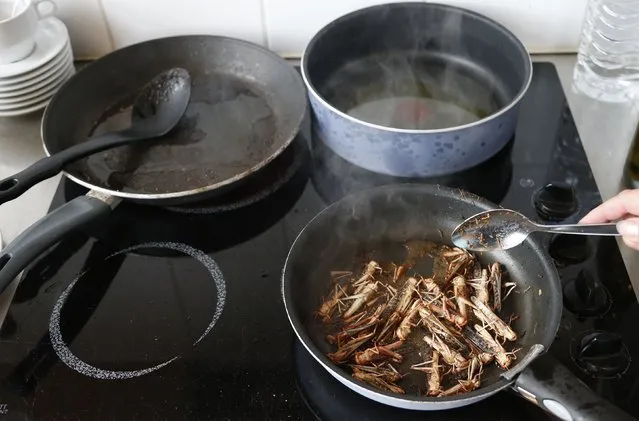
Locusts are cooked with olive oil for a discovery lunch in Brussels September 20, 2012. (Photo by Francois Lenoir/Reuters)
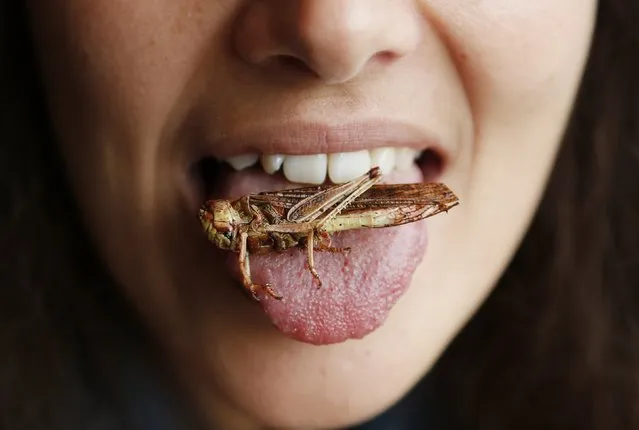
A woman poses with a locust on her tongue at a discovery lunch in Brussels September 20, 2012. Organisers of the event, which included cookery classes, want to draw attention to insects as a source of nutrition. (Photo by Francois Lenoir/Reuters)
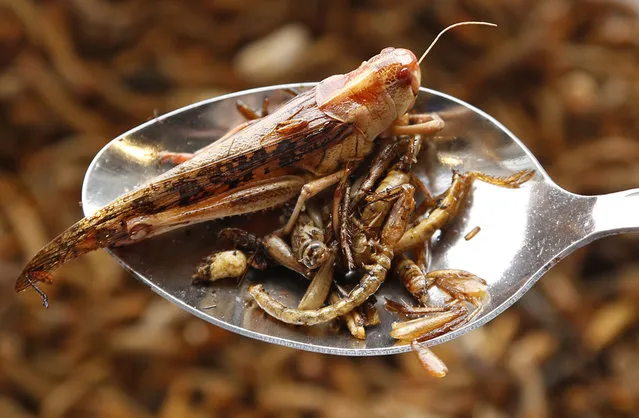
Locusts and worms are seen on a spoon after being cooked with olive oil for a discovery lunch in Brussels September 20, 2012. (Photo by Francois Lenoir/Reuters)

Two snakes are seen inside their compartment in wooden cupboards labelled “Poisonous Snakes”, at a snake soup store in Hong Kong January 29, 2013. There are scores of people in Hong Kong who have through generations tamed snakes to make soup out of them, a traditional cuisine believed to be good for the health. Yet the people behind providing fresh snakes for the savoury meal thought to speed up the body's blood flow and keep it strong in the cold winter months may be doomed, with young people increasingly reluctant to take on a job they see as hard and dirty. (Photo by Bobby Yip/Reuters)
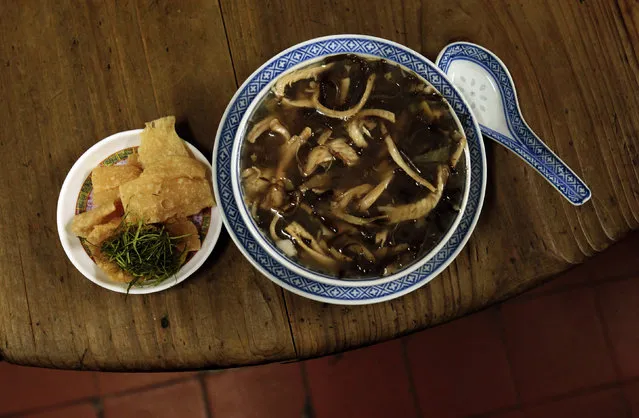
Snake meat is seen in a bowl of snake soup served at a snake soup shop in Hong Kong January 30, 2013. (Photo by Bobby Yip/Reuters)
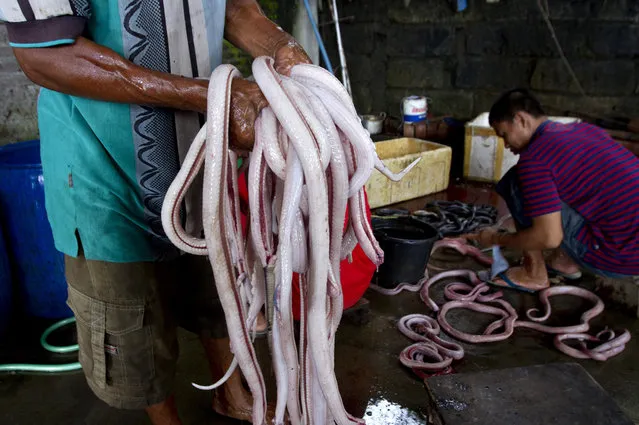
A worker holds cobra meat after the snakes have been stripped of their skins, at a Chinese restaurant in the ancient city of Yogyakarta April 1, 2011. Snake hunters catch about 1,000 cobras from Yogyakarta, Central Java and East Java provinces each week to harvest their meat for burgers, priced at 10,000 rupiah ($1.15) each, as well as satay and other dishes. Some customers said they believe cobra meat can cure skin diseases and asthma, and increase sexual virility. (Photo by Dwi Oblo/Reuters)
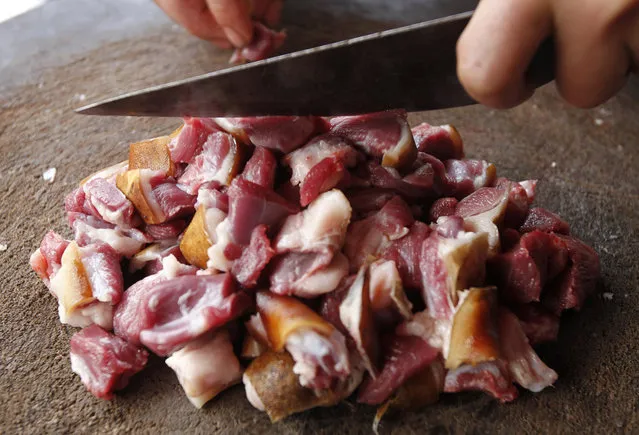
A vendor cuts dog meat for sale at his roadside stall in Duong Noi village, outside Hanoi December 16, 2011. While animal rights activists have condemned eating dog meat as cruel treatment of the animals, it is still an accepted popular delicacy for some Vietnamese, as well in some other Asian countries. Duong Noi is well-known as a dog-meat village, where hundreds of dogs are killed each day for sale as popular traditional food. Dog-eating as a custom is rooted in Vietnam and was developed as a result of poverty. One kilogram of dog meat costs about 130,000 dongs ($6.2). (Photo by Reuters/Kham)
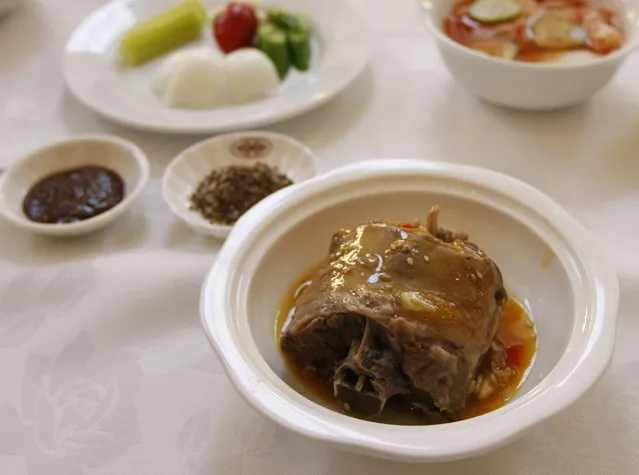
Dog meat or “Dan go gi” in North Korean expression, is placed on a table at a famous restaurant in Pyongyang November 13, 2008. (Photo by Lee Jae-Won/Reuters)
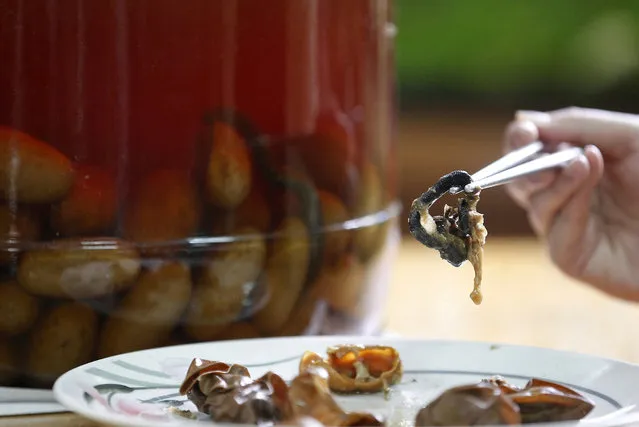
A cobra embryo is displayed at a snake farm ahead of the Spring Festival in Tainan, southern Taiwan, February 5, 2013. Eating cobra eggs with embryo is believed to be good for health, according to snake farm owner Huang Kuo-nan. The Lunar New Year, also known as the Spring Festival, begins on February 10 and marks the start of the Year of the Snake, according to the Chinese zodiac. (Photo by Pichi Chuang/Reuters)
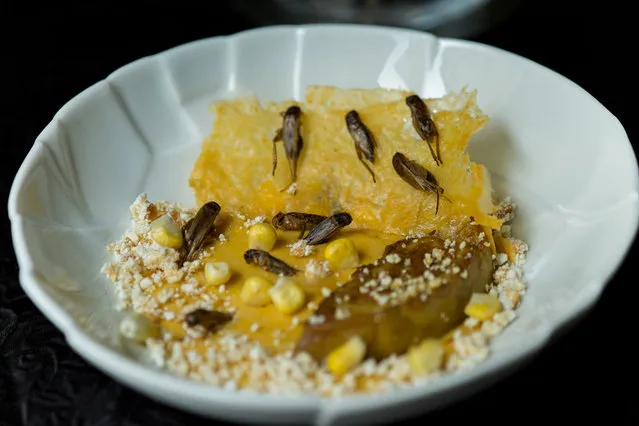
A starter dish “Cremeux de mais, fois gras et croustillant de grillons au sarrasin” – creamy corn with crickets' prepared by French chef David Faure in his restaurant “Aphrodite” in Nice on May 2, 2013 in Nice, France. Crickets and worms as produce for culinary requirements cost up to 1250 euros per kilogramme on May 2, 2013 in Nice, France. Faure's restaurant, renowned for it's innovative and inventive cuisine, has been awarded one star in the Michelin Guide. (Photo by Didier Baverel/Getty Images)
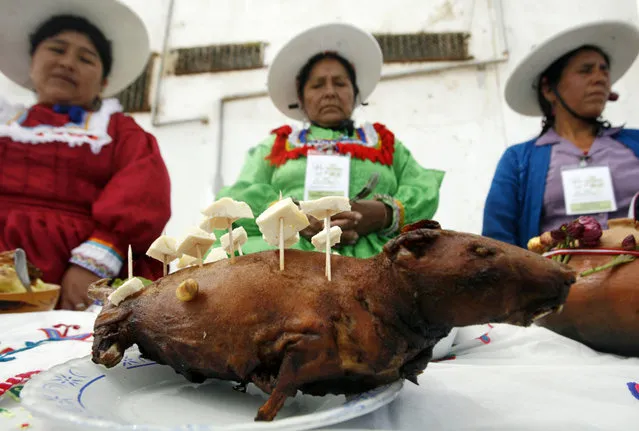
Andean women display a dish of roasted cuy during a guinea pig festival in Huacho, northern Lima, July 20, 2008. The one-day festival includes an animal show and a food and fashion contest which features the guinea pig, native to the Andes. Cuy, a traditional fried or roasted guinea pig dish, dates back at least fifteen centuries to pre-Incan times. (Photo by Mariana Bazo/Reuters)
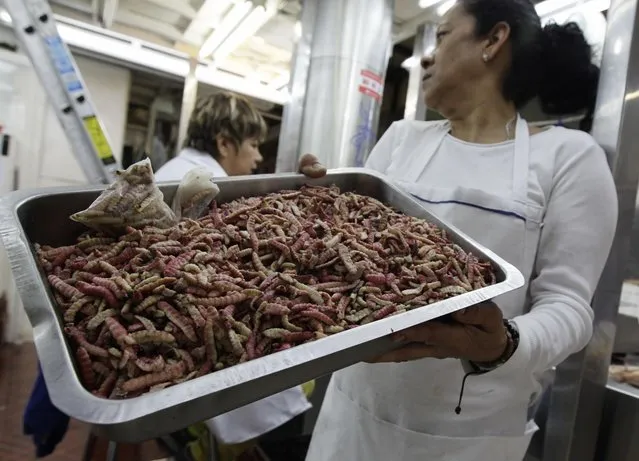
A woman holds a tray of maguey worms at the San Juan food market in Mexico City June 19, 2013. Mexico's taste for eating creepy crawlies, originating from the Pre-Columbian era, could be the answer to ending hunger. United Nations Food and Agricultural Organisation (FAO) is encouraging the production of edible insects to supplement diets in areas where malnutrition is rife and as a measure to combat obesity. Nowhere has the message been more warmly received than in Mexico where insects have been part of the diet for hundreds of years. Pre-Columbian civilizations in the country ate them frequently as a main source of protein because meat through cattle raising did not exist. Although conquistadors discouraged insect consumption, ethnic groups in the country continued to eat them. (Photo by Henry Romero/Reuters)

A Chinese woman eats from an ox and dog pen*s dish at the Guolizhuang “strength in the pot” pen*s restaurant in China's capital Beijing March 3, 2006. The restaurant offers more than 30 types of animal penises served in a Chinese hotpot style. According to the theory of traditional Chinese medicine, the pen*s of certain animals is full of nutrients which brings men energy. And because it contains gelatine albumen, it is said to have excellent cosmetic effects for women, especially beneficial for the skin. (Photo by Reinhard Krause/Reuters)
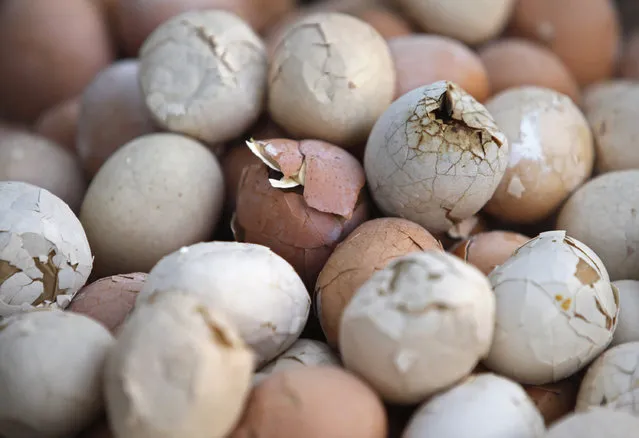
Hard-boiled eggs cooked in boys' urine lie inside a pot for sale in Dongyang, Zhejiang province March 26, 2012. It's the end of a school day in the eastern Chinese city of Dongyang, and eager parents collect their children after a hectic day of primary school. But that's just the start of busy times for dozens of egg vendors across the city, deep in coastal Zhejiang province, who ready themselves to cook up a unique springtime snack favoured by local residents. (Photo by Aly Song/Reuters)
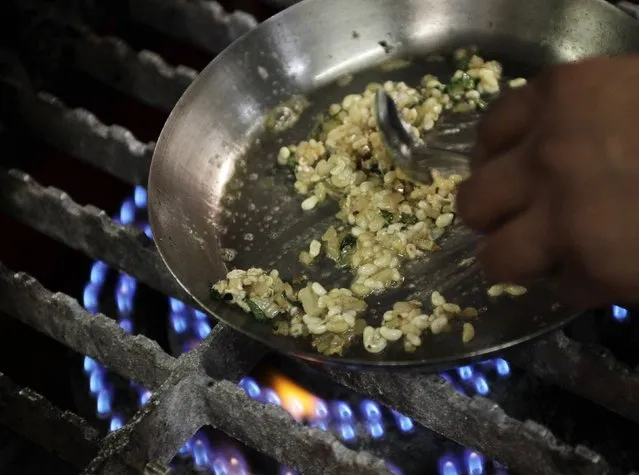
Mexican chef Alejandro Pinon fries ant eggs at the Corazon de Maguey restaurant in Mexico City June 18, 2013. (Photo by Henry Romero/Reuters)
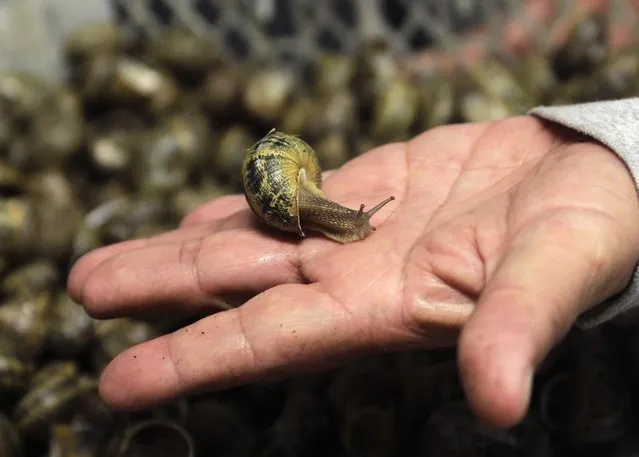
A vendor holds a snail for sale in his palm at the San Juan food market in Mexico City June 19, 2013. (Photo by Henry Romero/Reuters)
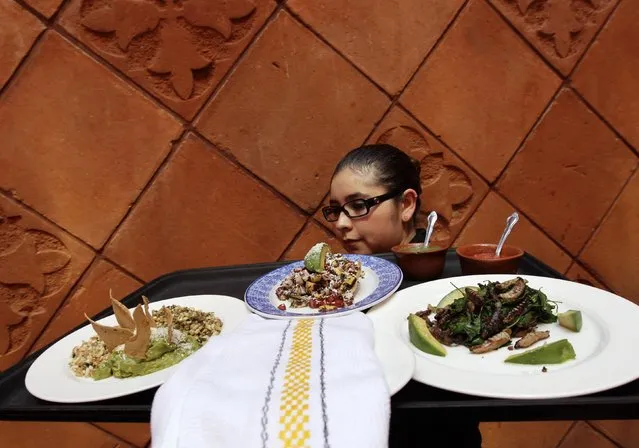
A waitress carries plates of ant eggs (L), maguey worms (R) and grasshoppers at the Corazon de Maguey restaurant in Mexico City June 18, 2013. (Photo by Henry Romero/Reuters)
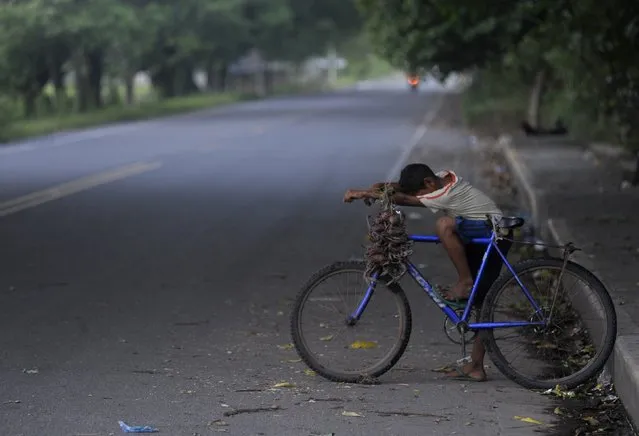
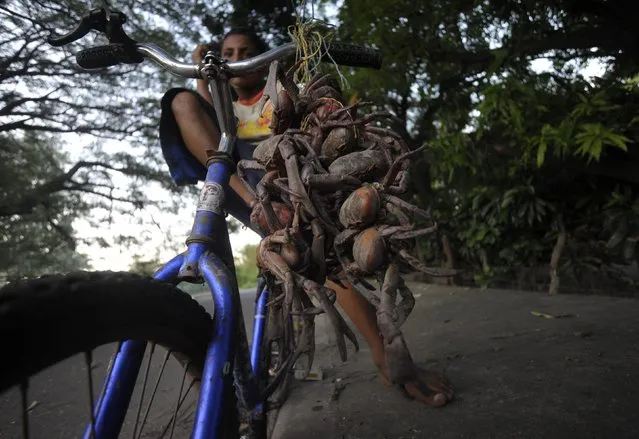
A boy sits on his bicycle while waiting for customers to buy his crabs on a street in Cedeno, 150 km (93 miles) south of Honduras September 12, 2012. (Photo by Jorge Cabrera/Reuters)
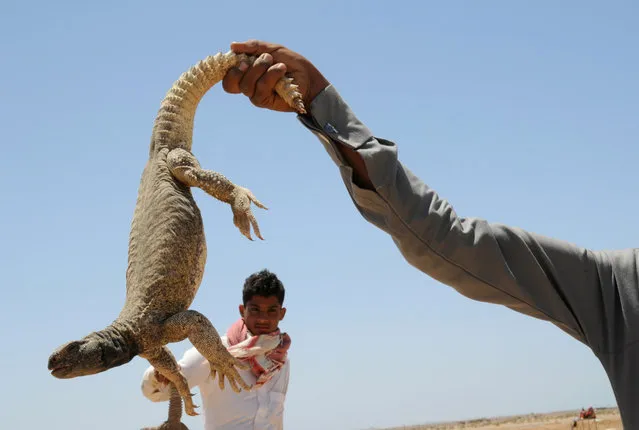
A man holds an Uromastyx lizard, also known as a dabb lizard, in a desert near Tabuk April 19, 2013. The lizards, which are considered a delicacy in some parts of the Middle East, are caught in the spring season using hooks and sniffer dogs as well as bare hands. The lizards can be grilled or eaten raw, and according to popular belief, their blood is used to strengthen the body and treat diseases. (Photo by Mohamed Al Hwaity/Reuters)
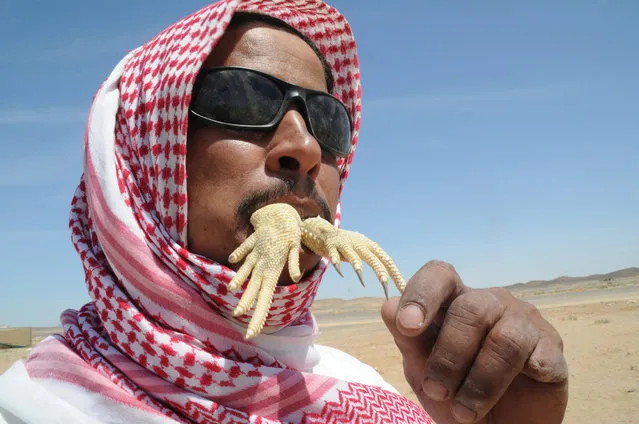
A man eats a part of an Uromastyx lizard, also known as a dabb lizard, in a desert near Tabuk April 19, 2013. (Photo by Mohamed Al Hwaity/Reuters)
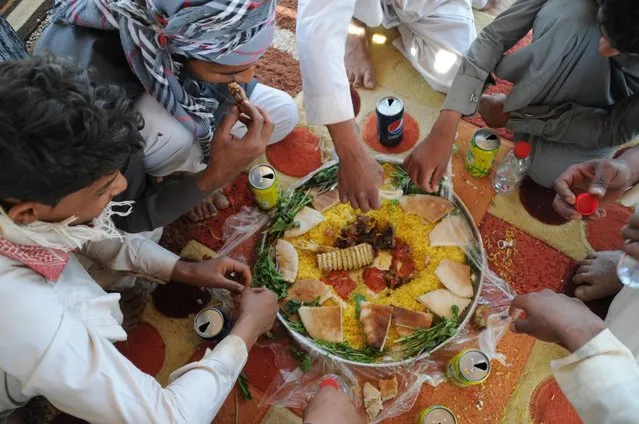
A traditional dish known as Kabsa is seen with a tail of an Uromastyx lizard, also known as a dabb lizard, in a desert near Tabuk April 19, 2013. (Photo by Mohamed Al Hwaity/Reuters)
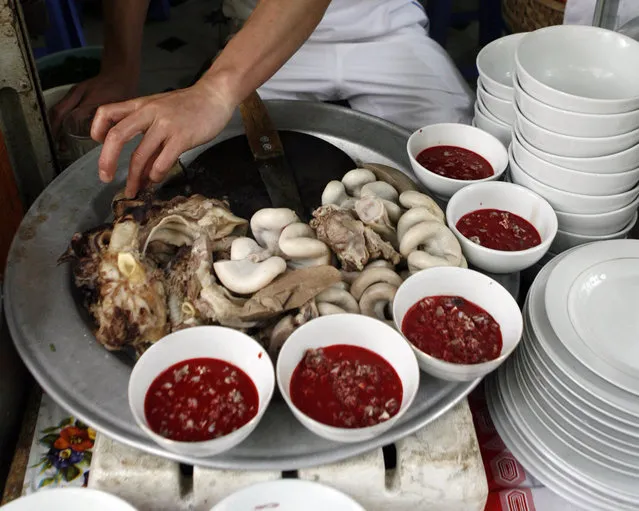
A raw blood dish is displayed with cooked entrails at a restaurant in Hanoi April 28, 2009. Frozen pudding from fresh duck or pig blood is a popular dish in the Southeast Asian country although duck blood is less consumed following bird flu outbreaks that have killed at least 55 Vietnamese since late 2003. In Vietnam, there appeared to be a degree of confusion towards swine flu which is not in fact linked to pigs alone – but an assortment of swine, human and avian viruses. One bowl of raw blood costs VND10,000 ($0.55). (Photo by Reuters/Kham)
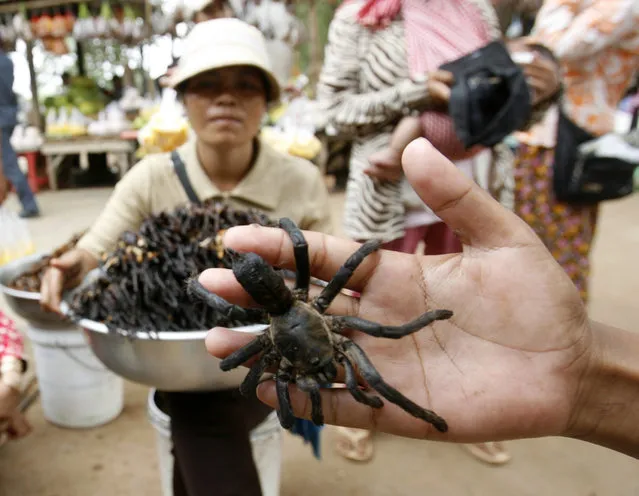
A vendor selling deep-fried spiders poses with a spider as she waits for customers at bus station at Skun, Kampong Cham province, east of Phnom Penh March 14, 2009. It costs $2 for 10 deep-fried spiders, which come seasoned with garlic. The fist-sized arachnids are crunchy on the outside and taste like cold, gooey chicken on the inside. (Photo by Chor Sokunthea/Reuters)
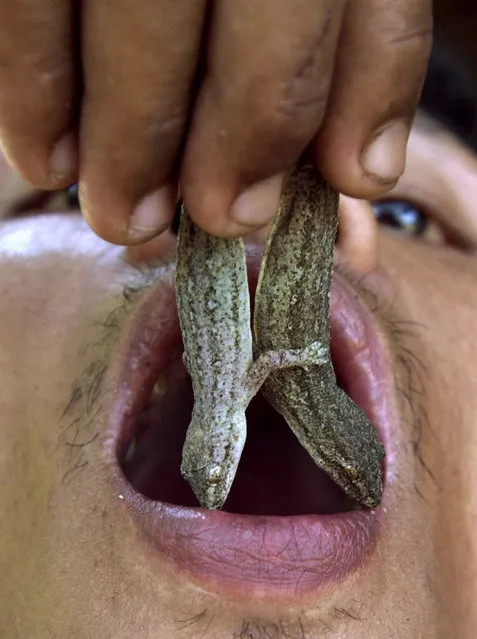
Thai farm employee Somsak Inta, 36, puts two house lizards in his mouth prior to eating them in Nakorn Nayok province, 60 kilometers away from Bangkok April 9, 2008. Somsak started eating lizards when was 16 as a means to treat health problems, which he claims could not be cured by modern medicine. He has since been eating lizards for over 20 years, believing, among other things, it increases his s*x drive. (Photo by Reuters)
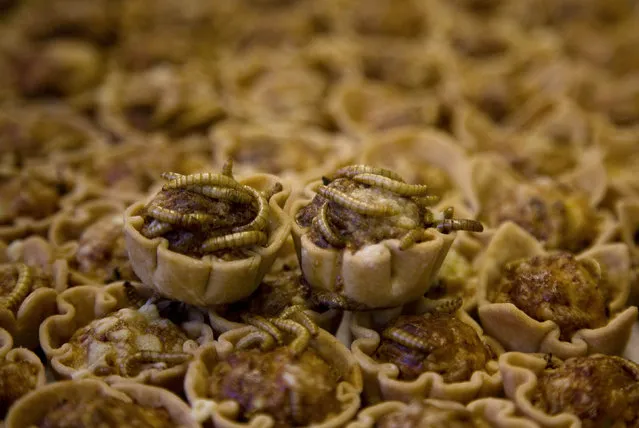
Mealworm quiches are seen at the Rijn IJssel school for chefs in Wageningen January 12, 2011. All you need to do to save the rainforest, improve your diet, better your health, cut global carbon emissions and slash your food budget is eat bugs. Mealworm quiche, grasshopper springrolls and cuisine made from other creepy crawlies is the answer to the global food crisis, shrinking land and water resources and climate-changing carbon emissions, Dutch scientist Arnold van Huis says. To attract more insect-eaters, Van Huis and his team of scientists at Wageningen have worked with a local cooking school to produce a cookbook and suitable recipes. (Photo by Jerry Lampen/Reuters)
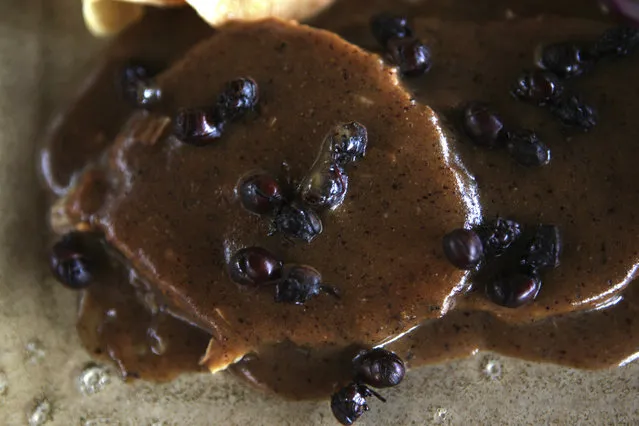
A typical dish in ant sauce is seen in the restaurant Color de Hormiga in Barichara May 19, 2009. Every year during the April-June season thousands of Colombian farmers and inhabitants of Santander province collect ants culonas (Atta Laevigata) as part of a traditional ritual in the region. The ants, named “Culonas” for their big size, are cooked and sold as exotic, specialized food. (Photo by Jose Miguel Gomez/Reuters)
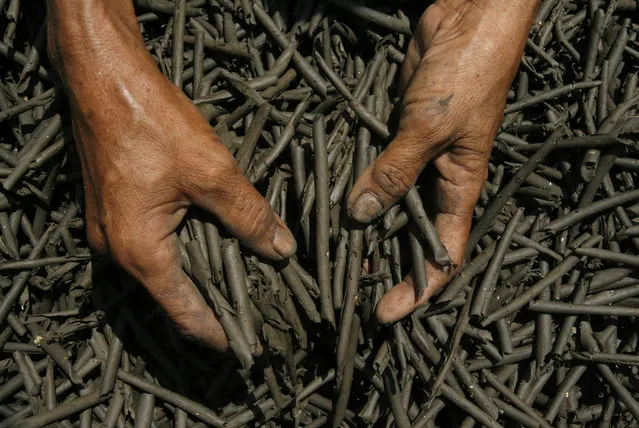
Rasima, a villager, dries “ampo”, a traditional snack made from clean, gravel-free dark earth, in Tuban, East Java province March 29, 2010. Rasima is the village's only ampo producer, and can earn up to $2 a day to supplement her family's income from farming. Although there is no medical evidence, villagers believe the soil snacks are an effective pain-killer and pregnant women are encouraged to eat them as it is believed to refine the skin of the unborn baby. (Photo by Sigit Pamungkas/Reuters)
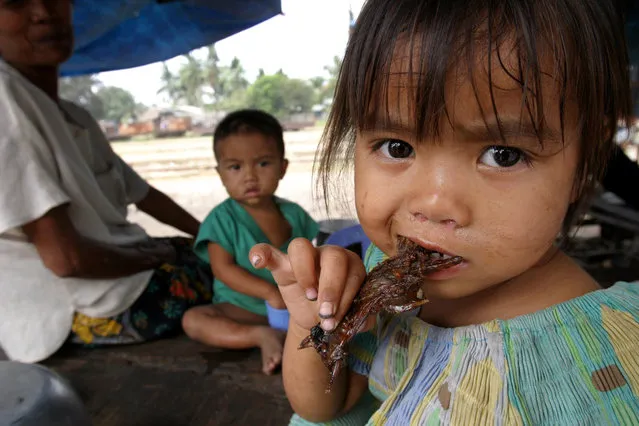
San Smey, 4, eats a piece of roasted rat in the provincial town of Battambang, 290 km (181 miles) northwest of the capital Phnom Penh February 19, 2004. Meat-eaters were forced to shy away from chicken because of the deadly bird flu virus that was rampant across Asia. (Photo by Chor Sokunthea/Reuters)
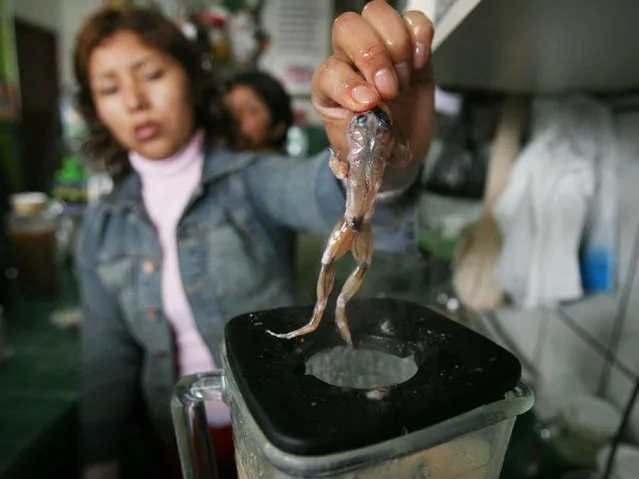
Ms Bertha Piranes drops a skinned frog into a blender to make a drink at a market in San Juan de Lurigancho, Lima, on Aug 16, 2006. The drink, popular with working-class Peruvians, is believed to cure illnesses ranging from fatigue to sexual impotency. (Photo by Reuters)
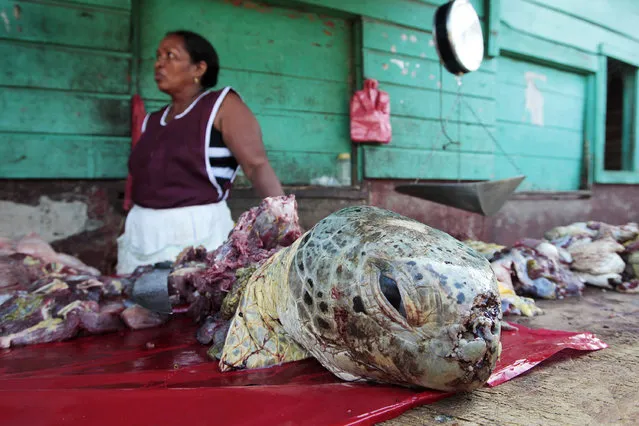
An indigenous Miskito woman sells turtle meat at a town market in Puerto Cabezas, along Nicaragua's Caribbean coast August 25, 2010. Around five hundred turtles are sold for food per month in the port. The going rate for turtle meat is approximately $1.10 per pound. (Photo by Oswaldo Rivas/Reuters)
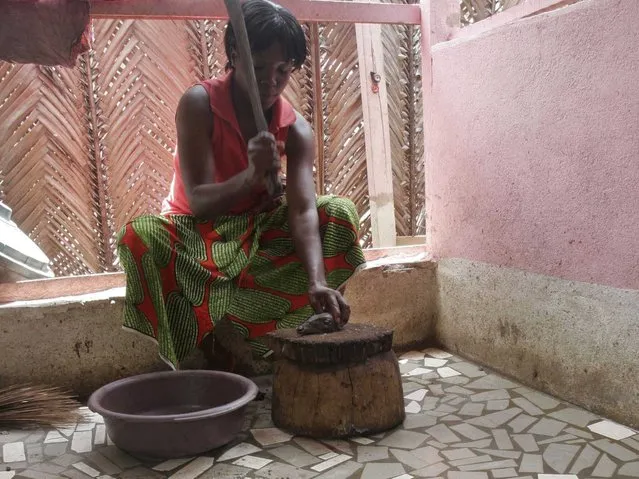
A worker cuts up a roasted cat in the back room of a restaurant in the Ivory Coast. Cat meat is a traditional food in much of Africa and Asia. (Photo by Reuters)
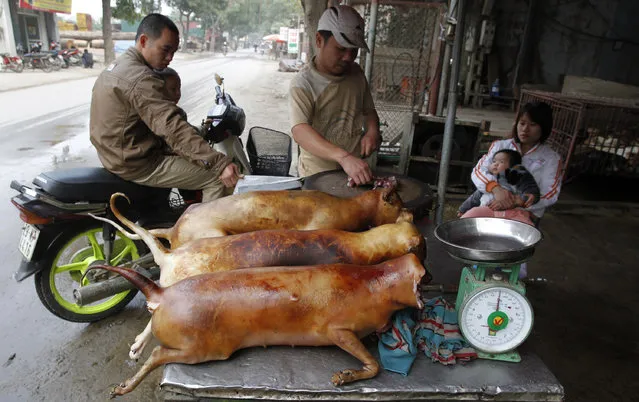
A vendor (C) cuts slaughtered dogs for sale at his roadside stall in Duong Noi village, outside Hanoi December 16, 2011. While animal rights activists have condemned eating dog meat as cruel treatment of the animals, it is still an accepted popular delicacy for some Vietnamese, as well in some other Asian countries. Duong Noi is well-known as a dog-meat village, where hundreds of dogs are killed each day for sale as popular traditional food. Dog-eating as a custom is rooted in Vietnam and was developed as a result of poverty. One kilogram of dog meat costs about 130,000 dongs ($6.2). (Photo by Reuters/Kham)
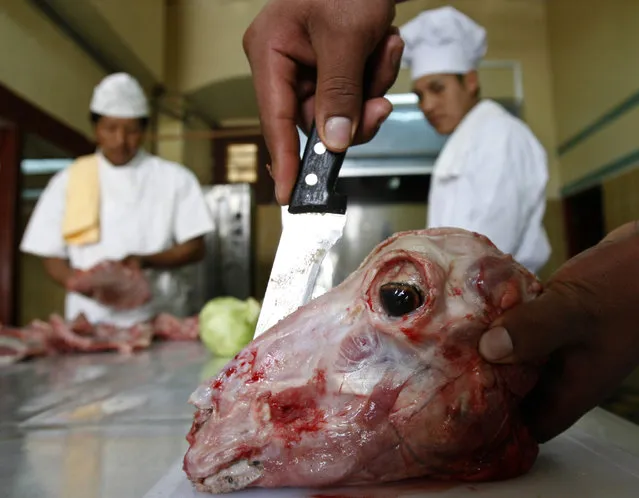
Cooks at the Solar de las Cabecitas (House of the Little Heads) restaurant prepare their specialty, boiled sheep's head served on a bed of rice, in La Paz August 17, 2006. The dish, a delicacy in the Andean mining city of Oruro where the salty highland pasture gives the lamb its particular flavor, is the specialty of the restaurant which counts among its clientele Bolivian Foreign Minister David Choquehuanca and President Evo Morales. (Photo by David Mercado/Reuters)
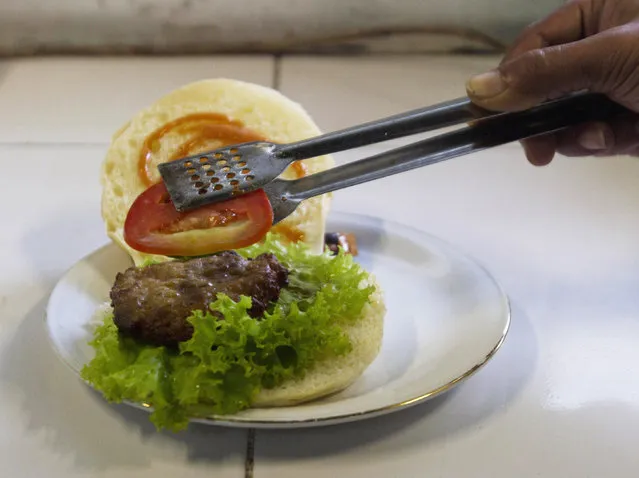
A chef prepares a cobra meat burger at a Chinese restaurant in the ancient city of Yogyakarta April 1, 2011. Snake hunters catch about 1,000 cobras from Yogyakarta, Central Java and East Java provinces each week to harvest their meat for burgers, priced at 10,000 rupiah ($1.15) each, as well as satay and other dishes. Some customers said they believe cobra meat can cure skin diseases and asthma, and increase sexual virility. (Photo by Dwi Oblo/Reuters)
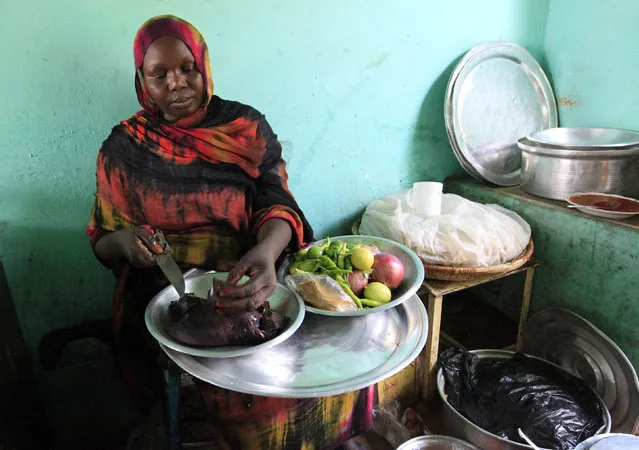
A woman prepares a dish of camel liver at her shop in Tamboal village market in Al Jazeera April 16, 2011. According to the Sudanese Ministry of Animals Resources in 2003, the country produced about 72,000 to 81,000 tonnes of camel meat annually from 1996 to 2002. (Photo by Mohamed Nureldin Abdallah/Reuters)
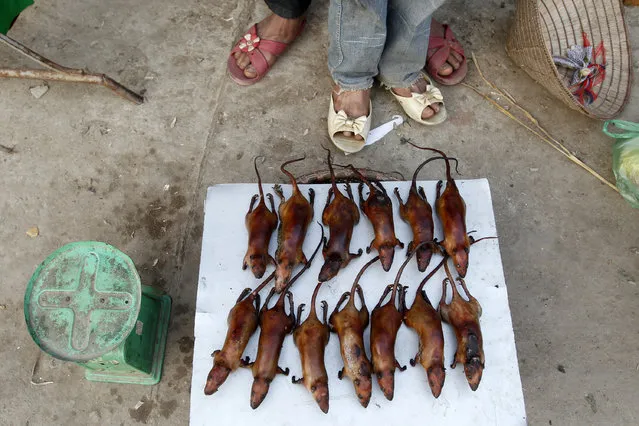
Slaughtered rats are displayed for sale at the market of Canh Nau village, 40 km (25 miles) west of Hanoi December 25, 2011. Canh Nau is known as rat meat village where people eat rats as well as other kinds of meat from animals such as pigs, cows and chickens. One kilogram of slaughtered rats costs 80,000 dong ($3.80). Rats were eaten as a result of poverty in the past but now they are eaten at the end of every month of the lunar calendar as a special dish and local media reported that an average of a hundred kilograms of rat are sold at the village per day. (Photo by Reuters/Kham)
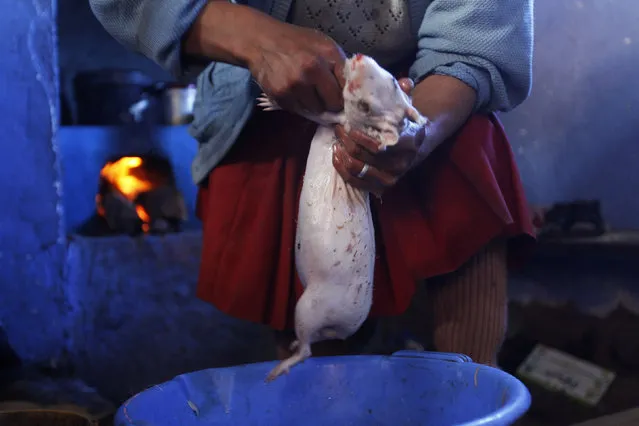
Octavia Ccahuata prepares a guinea pig for cooking in her kitchen, which is fitted with cooking equipment that save energy and reduce smoke emission as part of the “Hot Clean House” ecology project in the Andean town of Langui in Cuzco March 9, 2012. The Pontifical Catholic University of Peru (PUCP) developed the “Hot Clean House” project, which uses solar power to warm houses and energy-saving technologies for cooking to counter extreme cold weather in the highlands. These technologies have been implemented in communities in the highlands of Cuzco. (Photo by Mariana Bazo/Reuters)
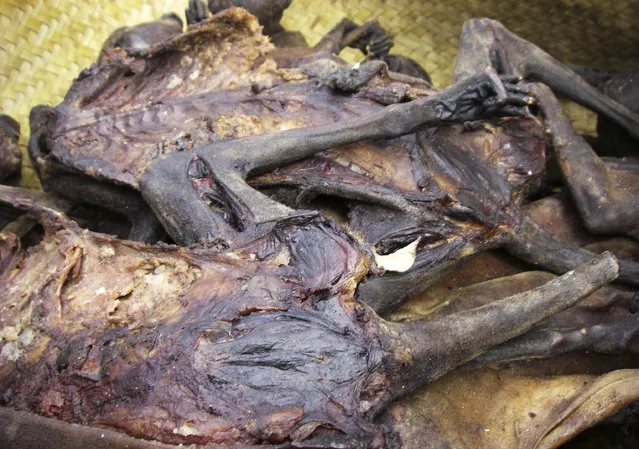
Lemurs illegally killed by poachers in Madagascar to be sold to restaurants as “luxury” bushmeat are seen in this undated handout photograph. Endangered lemur species found only in Madagascar are being slaughtered and served up in local restaurants as poachers take advantage of a security vacuum on the island after a coup earlier this year. (Photo by Joel Narivony/Reuters/Fanamby)
16 Jul 2013 11:40:00,
post received
0 comments
